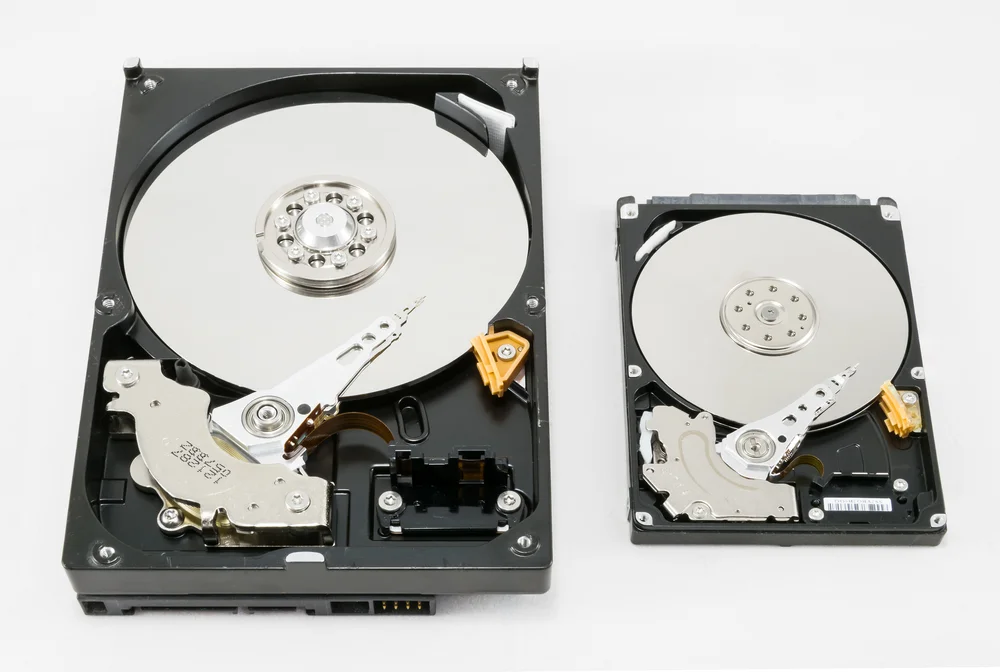GLOSSARY
What is an HDD?
An HDD is a hard disk drive, as it uses solid platters covered in magnetic film to store data for a variety of devices, hence the words “hard disk” in its name. These storage devices have been used in computers since the 1950s, and are still used today although on a much smaller scale for consumer devices than in previous decades due to the rise of solid-state drives as a speedier replacement.
Hard drives are non-volatile devices, meaning they can store data even when there is no power going to the drive. This is the opposite of PC memory aka DRAM, which is volatile, and requires power to store data.
The Parts of a Hard Drive
The main components of an HDD are the metal or ceramic platters covered in a magnetic film that stores data, and read/write heads that hover over the surface of the platters and transfer data back and forth to the host system. These read/write heads are used on every platter surface in a hard drive so they are typically found on both sides of a platter, so if it’s a 10-platter drive, there are usually 20 read/write heads. These tiny read/write heads are attached to actuator arms that extend over the platters from the base of the drive, where a small motor controls their operation. The magnetized platters are typically referred to as “media” since they can store data.

The Benefits
The main benefit of a hard disk drive is it can store a lot of data at a very low cost, which has made them the de facto storage type for computers over the past 60+ years. These days they are still widely used throughout the world but more increasingly for enterprise environments such as in data centers and servers due to their ability to store massive amounts of data at a very low cost compared to solid-state drives.
How a Hard Drive Works
When data is requested from the host system, such as a person navigating to a folder and double-clicking a file or folder, the actuator arm with the read/write heads is moved into position over the spinning platter where that particular piece of data is located, and the tiny chunk of data is read by the drive and sent to the host system.
When data is being written to the drive, the process is the same but in reverse, where the arm moves to an empty area and the read/write head adds new data to the disk, or writes over data that was marked for deletion.
The data on the platters is stored in what is called a "bit," which is resembles a microscopic grain of rice. The read/write heads are able to create magnetic fields with the bits on the platters, with one end of the bit being the North Pole and the other end being the South Pole, and this orientation represents the binary state of each bit on the disk. The read/write head examines the magnetic fields of the bits and translates them into usable data. When data is being written, the read/write heads can magnetize certain areas of the disk, flipping the bits into an up-or-down state, forming the binary foundation of all data.
The bit is the smallest unit of data on a hard drive, and 8 bits form a byte, then 1,000 bytes are a Kilobyte, a thousand kilobytes is a megabyte, and each grouping of 1,000 units leads to a gigabyte, terabyte, petabyte, and so forth. Taken as a whole, this is how we measure a hard drive’s total capacity, which these days is in terabytes.
RIP HDD
Hard drives have fallen out of favor for consumer devices due to the arrival of solid-state drives, or SSD for short, which as the name states have no moving parts. This lack of moving parts makes them much faster than a drive with a spinning platter, as you don’t have to wait for the read/write head to get into position, and the “seek” time, which is how long it takes to reposition the head, is nonexistent on an SSD since there are no moving parts.
Most if not all of the performance bottlenecks that exist in hard drives due to their design do not exist in SSDs, making them much faster than HDDs, while also making them much more reliable as they can be bumped and jostled without worrying about the read/write head “crashing” into the platter, which can kill a hard drive. The downside is SSDs are still much more expensive than HDDs, which is why data centers and servers still rely on hard drives for storing large amounts of data as doing so with SSDs is cost prohibitive still.
Impressive Engineering
Despite hard drives not being used for consumer devices much these days due to the myriad benefits of SSDs, they are still marvels of modern engineering. For example, the read/write heads must float on top of the spinning platters without ever touching them, but be close enough to manipulate the data on the disk, so the distance between the head and the platter is roughly 3-5 nanometers, which is as thin as a human fingerprint, or the height of several strands of human DNA stacked on top of each other. For context, the width of a single human hair is 80,000 nanometers.
What’s even more amazing is the spinning of the platters is what provides the airflow for the head to “fly” above the platter, and it’s able to float at this impossibly small distance despite the turbulence caused the disk spinning directly below it, usually at speeds up to 7,200 revolutions per minute, or 120 revolutions per second.
Despite their relatively slow performance, the engineering and precision that goes into a modern hard drive is breath taking, at least to nerds like us (and maybe you).